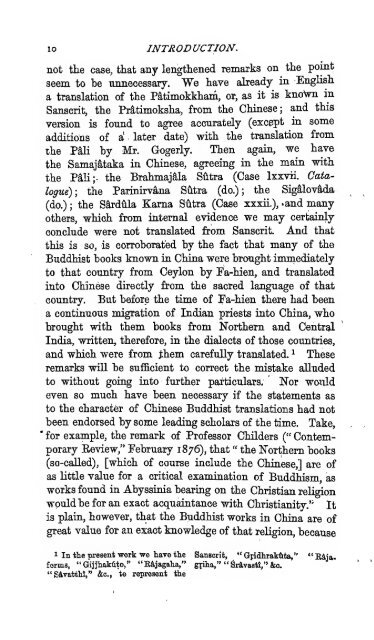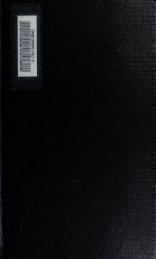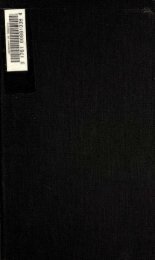Texts from the Buddhist canon : commonly known as Dhammapada
Texts from the Buddhist canon : commonly known as Dhammapada
Texts from the Buddhist canon : commonly known as Dhammapada
You also want an ePaper? Increase the reach of your titles
YUMPU automatically turns print PDFs into web optimized ePapers that Google loves.
10 INTRODUCTION.<br />
not <strong>the</strong> c<strong>as</strong>e, that any leng<strong>the</strong>ned remarks on <strong>the</strong> point<br />
seem to he unnecessary. We have already in English<br />
a translation of <strong>the</strong> Patimokkham, or, <strong>as</strong> it is kno^im in<br />
Sanscrit, <strong>the</strong> PrS,timoksha, <strong>from</strong> <strong>the</strong> Chinese; and this<br />
version is found to agree accurately (except in some<br />
additions of a later date) with <strong>the</strong> translation <strong>from</strong><br />
<strong>the</strong> PMi hy Mr. Gogerly. Then again, we have<br />
<strong>the</strong> Samajataka in Chinese, agreeing in <strong>the</strong> main with<br />
<strong>the</strong> Paii;- <strong>the</strong> BrahmajMa Sfitra (C<strong>as</strong>e Ixxvii. Cata-<br />
logue); <strong>the</strong> Parinu-vS,na Stoa (do.); <strong>the</strong> SigaiovMa<br />
(do.) ; <strong>the</strong> S§,rdula Kama Siitra (C<strong>as</strong>e xxxii.), .and many<br />
o<strong>the</strong>rs, which <strong>from</strong> internal evidence we may certainly<br />
conclude were not translated <strong>from</strong> Sanscrit. And that<br />
this is so, is corroborated by <strong>the</strong> fact that many of <strong>the</strong><br />
<strong>Buddhist</strong> books <strong>known</strong> in China were brought immediately<br />
to that country <strong>from</strong> Ceylon by Fa-hieil, and translated<br />
into Chinese directly <strong>from</strong> <strong>the</strong> sacred language of that<br />
country. But before <strong>the</strong> time of Fa-hien <strong>the</strong>re had been<br />
a continuous migration of Indian priests into China, who<br />
brought with <strong>the</strong>m books <strong>from</strong> Nor<strong>the</strong>rn and Central<br />
India, written, <strong>the</strong>refore, in <strong>the</strong> dialects of those countries,<br />
and which were <strong>from</strong> Jhem carefully translated. ^ These<br />
remarks will be sufficient to correct <strong>the</strong> mistake alluded<br />
to without going into fur<strong>the</strong>r particulars; Nor would<br />
even so much have been necessary if <strong>the</strong> statements <strong>as</strong><br />
to <strong>the</strong> character of Chinese <strong>Buddhist</strong> translations had not<br />
been endorsed by some leading scholars of <strong>the</strong> time. Take,<br />
' for example, <strong>the</strong> remark of Professor Childers (" Contem-<br />
porary Eeview," February 1876), that " <strong>the</strong> Nor<strong>the</strong>rn books<br />
(so-called), [which of course include <strong>the</strong> Chinese,] are of<br />
<strong>as</strong> little value for a critical examination of Buddhism, <strong>as</strong><br />
works found in Abyssinia bearing on <strong>the</strong> Christian religion<br />
would be for an exact acquaintance with Christianity.'' It<br />
is plain, however, that <strong>the</strong> <strong>Buddhist</strong> works in China are of<br />
great value for an exact knowledge of that religion, because<br />
1 In <strong>the</strong> present work we have <strong>the</strong> Sanscrit, " Gpdhrat6ta," " Eija.<br />
forms, "Giijhakiito," "ESjagaha," gpha," "graT<strong>as</strong>tl,"&o.<br />
"Sivatthl," &o., to represent <strong>the</strong>





